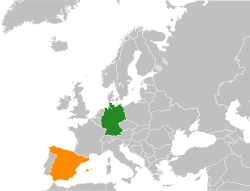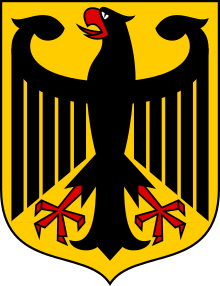Germany–Spain relations
 | |
Germany |
Spain |
|---|---|
Germany has an embassy in Madrid and consulates-general in Barcelona and Seville.[1] Spain has an embassy in Berlin and consulates-general in Düsseldorf, Frankfurt, Hamburg, Hanover, Munich and Stuttgart.[2] Both countries belong to the European Union, NATO and are members of the Eurozone.
Country comparison
| Coat of Arms |  |
.svg.png) |
| Flag |  |
 |
| Population | 82,200,000 | 46,354,321 [lower-alpha 1] |
| Area | 357,021 km² (137,847 sq mi) | 505,990 (195,364 sq mi) |
| Population density | 246/km² (637/sq mi) | 92/km² (240/sq mi) |
| Capital | Berlin | Madrid |
| Largest city | Berlin – 3,431,700 (4,500,000 Metro) | Madrid – 3,141,991 (6,529,700 Metro) |
| Government | Federal parliamentary republic | Unitary parliamentary constitutional monarchy |
| First Leader | Konrad Adenauer | Charles V, Holy Roman Emperor |
| Current Leader | Angela Merkel | Felipe VI of Spain (King), Pedro Sanchez (Prime Minister) |
| Official languages | German (de facto and de jure) | Spanish (de facto) |
| Main religions | 59.3% Christianity, 34.4% non-religious, 5.5% Islam, 0.8% other[4] | 69% Roman Catholic, 15.5% irreligious, 10.2% Atheist, 5.3% other [5] |
| Ethnic groups | 81% German, 4% Turkish, 2% Polish, 1.5% Russian, 11% other | 89.9 % Spaniards, 10.1% others |
| Expatriates | 146,846 Spaniards living in Germany[6][6] | 149,522 Germans living in Spain [7] |
| GDP (nominal) | $3.4 trillion[8] ($44,184 per capita)[9] | $1.307 trillion ($28,212 per capita)$1.769 trillion[10] |
| GDP (PPP) | $4.149 trillion ($50,206 per capita) | $1.307 trillion ($38,171 per capita) |
German community of Spain
See German Spaniards.
Related groups: Austrian Spaniards.
References
- ↑ "Representaciones de Alemania en España - Página principal". www.spanien.diplo.de (in Spanish). Retrieved 2016-04-08.
- ↑ "Páginas - Embajada de España en Alemania". www.exteriores.gob.es (in Spanish). Retrieved 2016-04-08.
- ↑ "Cifras de Población a 1 de julio de 2016. Estadística de migraciones. Primer semestre de 2016. Datos Provisionales" (in Spanish). Instituto Nacional de Estadística (INE). 16 December 2016.
- ↑ Numbers and Facts about Church Life in Germany 2016 Report. Evangelical Church of Germany. Retrieved 14 June 2017.
- ↑ Centro de Investigaciones Sociológicas (Centre for Sociological Research) (October 2017). "Barómetro de septiembre de 2017" (PDF) (in Spanish). Retrieved 27 December 2017.
- 1 2 "Padrón de Españoles Residentes en el Extranjero (PERE)" (PDF). Retrieved 5 December 2015.
- ↑ For 2013 and 2014
- ↑ https://web.archive.org/web/20180105221633/http://statisticstimes.com/economy/countries-by-projected-gdp.php
- ↑ "World Economic Outlook Database, April 2017, Germany". International Monetary Fund. April 2017. Retrieved 1 October 2017.
- ↑ "Spain". International Monetary Fund. Retrieved 8 May 2017.
- ↑ As of July 2017 (www.worldometers.info/world-population/spain-population), Spain's population was 46,468,102. In the same month the number of citizens with Spanish citizenship reached 41,996,253. The number of foreigners (i.e. immigrants, ex-pats and refugees) permanently living in Spain was estimated to be at 4,426,811 (9.54%) in 2015.[3]
This article is issued from
Wikipedia.
The text is licensed under Creative Commons - Attribution - Sharealike.
Additional terms may apply for the media files.